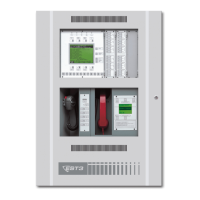Installation
EST3 Installation and Service Manual 5.35
Programming considerations
Accounts and receivers
In addition to the general operating characteristics of the
3-MODCOM, you’ll need to specify each account and receiver
used by the system. You may want to gather this information
before you begin using the SDU.
A receiver is a destination for a 3-MODCOM call to a CMS.
Typically, a CMS will have many receivers in operation, each
capable of receiving multiple calls. The CMS will determine
which receiver you should use for each account. For
configuration purposes, here’s what you’ll need to specify about
the receiver:
• Label
• Description
• Primary telephone number
• Secondary telephone number
• Protocol to use
• Maximum number of dial attempts
• Wait time between dial attempts
An account links a specific end user to a specific receiver. Each
message sent from the 3-MODCOM includes an account number
assigned by the CMS. This identifies the user site sending the
message and the receiver to which the message is sent. For each
account you’ll need to define:
• Label
• Description
• Receiver to use
• Account number (as assigned by the CMS)
• Dialing test interval and time of day
Several accounts may use the same receiver, but each account is
assigned to only one receiver.
Events and commands
One event and two commands are particularly important when
you create SDU rules for the 3-MODCOM. These are:
activation, activate, and send.
Security and access control devices do not send event messages
to the CPU. Rather, they send requests to execute predefined
command lists. You need to define the command lists and assign
the correct command list for each security or access control
event.
Activation: an event that lets you define a command list.
Activate: a command that lets you execute a command list in a
rule.

